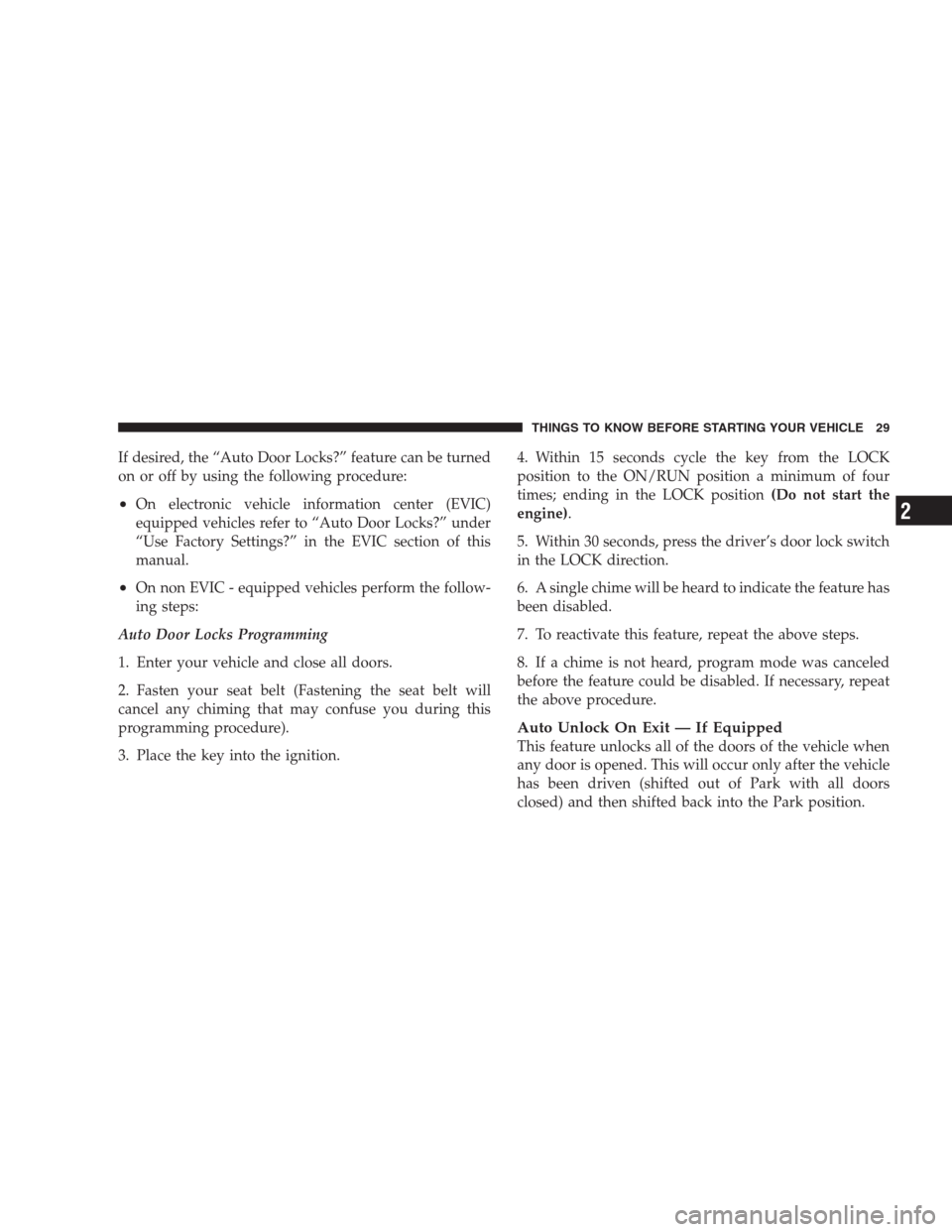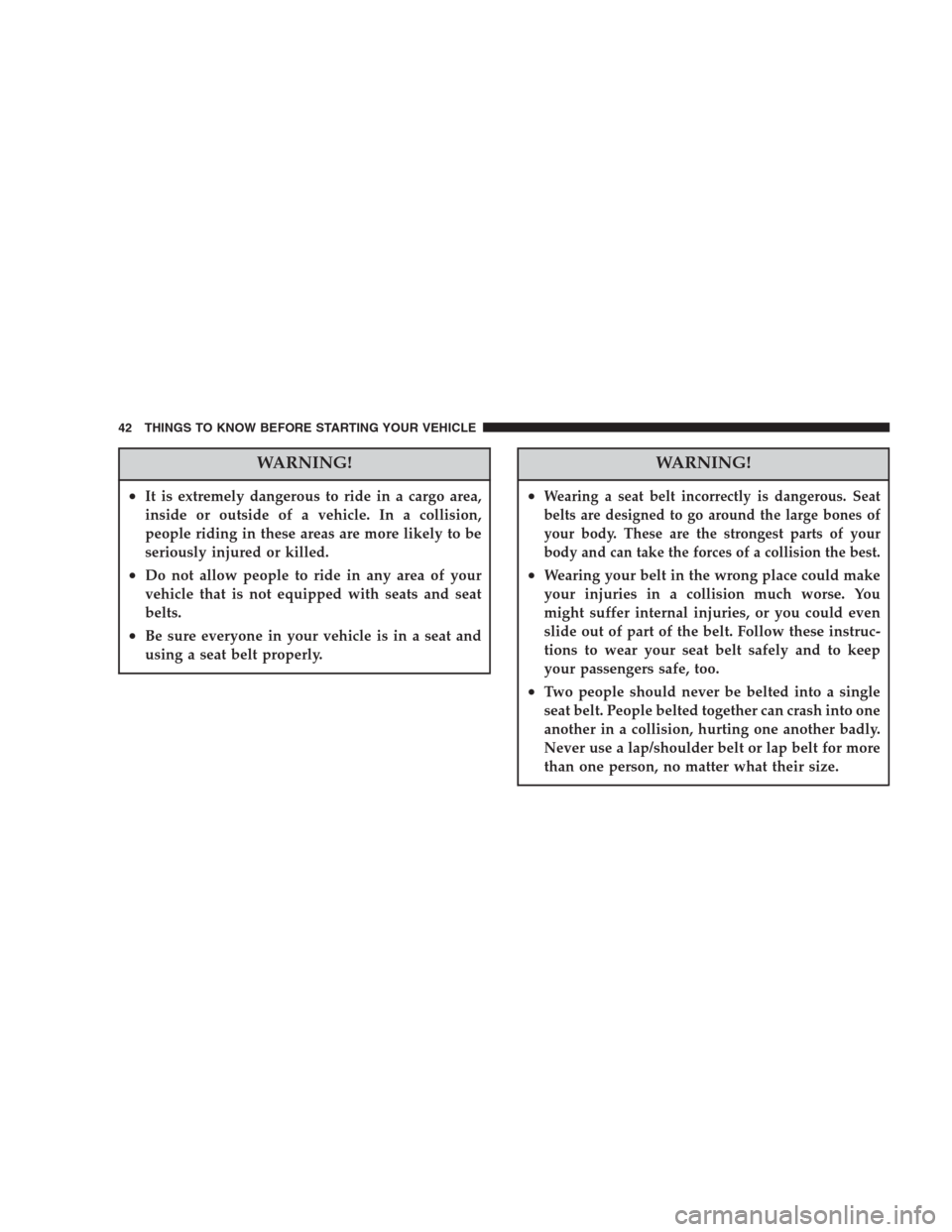Page 10 of 464

▫To Disarm The System...................19
▫Security System Manual Override...........19
�Illuminated Entry System..................20
�Remote Keyless Entry.....................20
▫To Unlock The Doors And Liftgate..........21
▫To Lock The Doors And Liftgate............22
▫To Open/Close Power Liftgate — If Equipped . .23
▫Flash Lights On Lock/Unlock.............23
▫Using The Panic Alarm..................24
▫Programming Additional Transmitters........25
▫Battery Replacement....................25
�Door Locks............................27
▫Manual Door Locks.....................27▫Power Door Locks.....................28
▫Child Protection Door Lock...............31
�Windows.............................33
▫Power Windows.......................33
�Liftgate...............................35
▫Power Liftgate — If Equipped.............37
�Occupant Restraints......................40
▫Lap/Shoulder Belts.....................41
▫Lap/Shoulder Belt Untwisting Procedure.....47
▫Seat Belt Pretensioners...................47
▫Enhanced Seat Belt Use Reminder System
(BeltAlert) — Driver Front Seat Only........48
▫Seat Belts And Pregnant Women............49
10 THINGS TO KNOW BEFORE STARTING YOUR VEHICLE
Page 11 of 464
▫Seat Belt Extender......................49
▫Driver And Front Passenger Supplemental
Restraint System - Airbag................50
▫Event Data Recorder (EDR)...............65
▫Child Restraint........................67
�Engine Break-In Recommendations...........79�Safety Tips............................79
▫Exhaust Gas..........................79
▫Safety Checks You Should Make Inside
The Vehicle..........................80
▫Periodic Safety Checks You Should Make
Outside The Vehicle....................81
THINGS TO KNOW BEFORE STARTING YOUR VEHICLE 11
2
Page 29 of 464

If desired, the “Auto Door Locks?” feature can be turned
on or off by using the following procedure:
•On electronic vehicle information center (EVIC)
equipped vehicles refer to “Auto Door Locks?” under
“Use Factory Settings?” in the EVIC section of this
manual.
•On non EVIC - equipped vehicles perform the follow-
ing steps:
Auto Door Locks Programming
1. Enter your vehicle and close all doors.
2. Fasten your seat belt (Fastening the seat belt will
cancel any chiming that may confuse you during this
programming procedure).
3. Place the key into the ignition.4. Within 15 seconds cycle the key from the LOCK
position to the ON/RUN position a minimum of four
times; ending in the LOCK position(Do not start the
engine).
5. Within 30 seconds, press the driver’s door lock switch
in the LOCK direction.
6. A single chime will be heard to indicate the feature has
been disabled.
7. To reactivate this feature, repeat the above steps.
8. If a chime is not heard, program mode was canceled
before the feature could be disabled. If necessary, repeat
the above procedure.
Auto Unlock On Exit — If Equipped
This feature unlocks all of the doors of the vehicle when
any door is opened. This will occur only after the vehicle
has been driven (shifted out of Park with all doors
closed) and then shifted back into the Park position.
THINGS TO KNOW BEFORE STARTING YOUR VEHICLE 29
2
Page 30 of 464

This feature will not operate if there is any manual
operation of the power door locks (Lock or Unlock). If
desired, the “Auto Unlock On Exit?” feature can be
turned on or off by using the following procedure:
•On electronic vehicle information center (EVIC)
equipped vehicles refer to “Auto Unlock On Exit?”
under “Use Factory Settings?” in the EVIC section of
this manual.
•On non EVIC - equipped vehicles perform the follow-
ing steps:
Auto Unlock On Exit Programming
1. Enter your vehicle and close all doors.
2. Fasten your seat belt (fastening the seat belt will cancel
any chimes that may be confusing during this program-
ming procedure).
3. Insert the key into the ignition.4. Within 15 seconds, cycle the key from the LOCK
position to the ON/RUN position a minimum of four
times ending in the LOCK position(do not start the
engine).
5. Within 30 seconds, press the driver’s door lock switch
in the UNLOCK direction.
6. A single chime will sound to indicate the feature has
been changed.
7. Repeat the above steps to alternate the availability of
this feature.
8. If a chime is not heard, program mode was canceled
before the feature could be changed. If necessary repeat
the above procedure.
NOTE:Use the Auto Door Locks and Auto Unlock
features in accordance with local laws.
30 THINGS TO KNOW BEFORE STARTING YOUR VEHICLE
Page 40 of 464
OCCUPANT RESTRAINTS
Some of the most important safety features in your
vehicle are the restraint systems. These include the front
and rear seat belts for the driver and all passengers, front
airbags for both the driver and front passenger, and if
equipped, left and right window bags for the driver and
passengers seated next to a window and a driver inflat-
able knee blocker. If you will be carrying children too
small for adult-size seat belts, your seat belts or the
LATCH feature (refer to the Child Restraint section in this
manual), can be used to hold infant and child restraint
systems.
NOTE:The front airbags have a multi stage inflator
design. This allows the airbag to have different rates of
inflation that are based on collision severity.
Passenger Airbag Disabled Light
40 THINGS TO KNOW BEFORE STARTING YOUR VEHICLE
Page 41 of 464

Please pay close attention to the information in this
section. It tells you how to use your restraint system
properly to keep you and your passengers as safe as
possible.
WARNING!
In a collision, you and your passengers can suffer
much greater injuries if you are not properly buck-
led up. You can strike the interior of your vehicle or
other passengers, or you can be thrown out of the
vehicle. Always be sure you and others in your
vehicle are buckled up properly.
Buckle up even though you are an excellent driver, even
on short trips. Someone on the road may be a poor driver
and cause a collision that includes you. This can happen
far away from home or on your own street.Research has shown that seat belts save lives, and they
can reduce the seriousness of injuries in a collision. Some
of the worst injuries happen when people are thrown
from the vehicle. Seat belts reduce the possibility of
ejection and the risk of injury caused by striking the
inside of the vehicle.Everyonein a motor vehicle should
be belted at all times.
Lap/Shoulder Belts
All the seats in your vehicle are equipped with Lap/
Shoulder Belts.
The belt webbing retractor is designed to lock during
very sudden stops or collisions. This feature allows the
shoulder part of the belt to move freely with you under
normal conditions. But in a collision, the belt will lock
and reduce the risk of your striking the inside of the
vehicle or being thrown out.
THINGS TO KNOW BEFORE STARTING YOUR VEHICLE 41
2
Page 42 of 464

WARNING!
•It is extremely dangerous to ride in a cargo area,
inside or outside of a vehicle. In a collision,
people riding in these areas are more likely to be
seriously injured or killed.
•Do not allow people to ride in any area of your
vehicle that is not equipped with seats and seat
belts.
•Be sure everyone in your vehicle is in a seat and
using a seat belt properly.
WARNING!
•Wearing a seat belt incorrectly is dangerous. Seat
belts are designed to go around the large bones of
your body. These are the strongest parts of your
body and can take the forces of a collision the best.
•Wearing your belt in the wrong place could make
your injuries in a collision much worse. You
might suffer internal injuries, or you could even
slide out of part of the belt. Follow these instruc-
tions to wear your seat belt safely and to keep
your passengers safe, too.
•Two people should never be belted into a single
seat belt. People belted together can crash into one
another in a collision, hurting one another badly.
Never use a lap/shoulder belt or lap belt for more
than one person, no matter what their size.
42 THINGS TO KNOW BEFORE STARTING YOUR VEHICLE
Page 43 of 464
Lap/Shoulder Belt Operating Instructions
1. Enter the vehicle and close the door. Sit back and
adjust the seat.
2. The seat belt latch plate is near the seatback of the
front seats and next to your arm in the rear seats. Grasp
the latch plate and pull out the belt. Slide the latch plate
up the webbing as far as necessary to allow the belt to go
around your lap.
Latch Plate
THINGS TO KNOW BEFORE STARTING YOUR VEHICLE 43
2